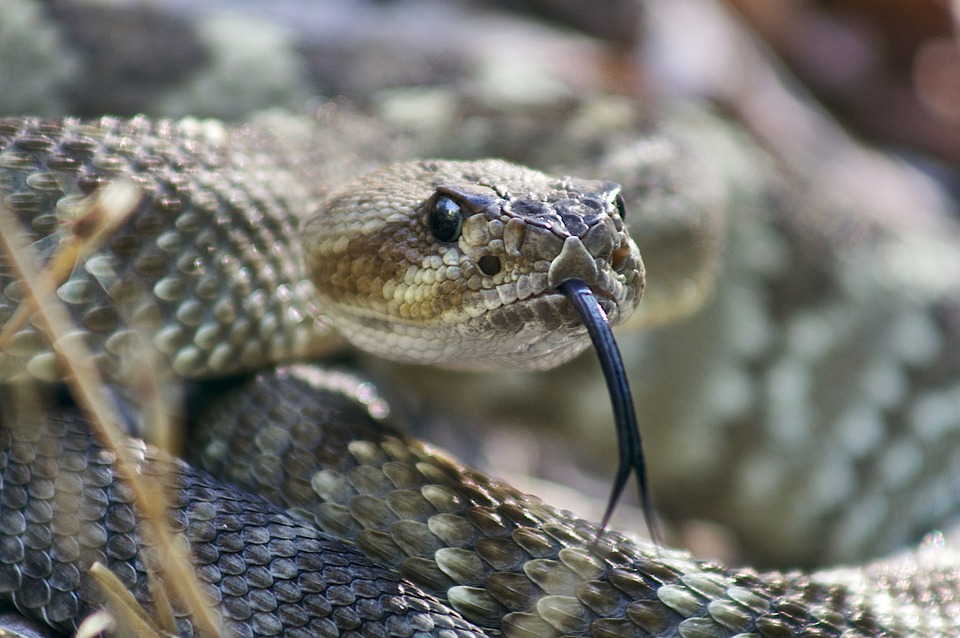A black tailed rattlesnake is on species found around Cache Valley,
LOGAN – The Utah Division of Wildlife Resources is reminding people that as the snow melts and warmer weather begins, rattlesnakes will begin emerging from their winter dens.

It is not unusual for people walking or hiking outdoors to encounter one of these reptiles. Make sure to always watch the trail ahead, and check carefully before stepping over rocks, reaching onto ledges or sitting down on a rock or log.
Terry Messmer, a wildlife specialist at Utah State University, said people should avoid walking the trails in Cache Valley when wearing ear buds.
“Hiking and running while on trials wearing ear buds will muffle the sound of a rattlesnake’s warning,” he said. “And don’t put your hands down in an area where they might be.”
Messmer said the only real rattlesnake in Cache Valley is the Great Basin rattlesnake that can grow up to five feet long, but the most common ones in the area are two to three feet long. The venomous vipers are tan or grey in color with black splotches on their back and rattles on their tails.
“We’ve had them come into the parks in Cache Valley,” he said. “They are found in rocky areas where they can corner prey and shelter from the heat.”
A rattlesnake’s camouflage helps it to blend into its surroundings, so you may pass by a rattlesnake and never know it.
“The chance of being bitten by a rattlesnake is rare,” Messmer said. “We have only had about 21 bites in Cache Valley over the years,” he said. “Most of those bites occurred because people tried to handle them or pick them up. It is wildlife country so just be aware.”
Utahns may see more snakes in their yards or irrigated fields, as the snakes search for water and prey. Snakes need a little water, but don’t need as much water as most mammals and birds.
Rattlesnakes are most active during the hot summer months at dawn and at dusk, though they can be encountered at all hours. Snakes mainly eat rodents, birds and other reptiles.
Many times people will pass by a rattlesnake and never know it.
It is illegal to kill or harass rattlesnakes; they are protected under Utah law unless you are threatened and defending yourself. Otherwise, it is a class B misdemeanor to kill a rattlesnake.
The Great Basin rattlesnake is an important part of Utah’s ecosystem and helps keep the rodent population in check.
“Like most animals, rattlesnakes fear humans and will do anything they can to avoid us,” DWR Native Species Coordinator Drew Dittmer said. “However, that changes if a snake thinks it’s threatened and there’s no way to escape. In that situation, the snake will often strike to protect itself. Just don’t approach it — give it plenty of space, and leave it alone. Respect the snake and its space, and you will be safe.”
If you are bitten by a rattlesnake, remain calm and seek immediate medical attention.

DWR gives the following instructions if someone encounters a rattlesnake:
- Remain calm and do not panic. Stay at least five feet from the snake. Make sure to give it plenty of space.
- Do not try to kill the snake. Doing so is illegal and greatly increases the chance the snake will bite you.
- Do not throw anything at the snake, like rocks or sticks. Rattlesnakes may respond to this by moving toward the person doing the throwing, rather than away from them.
- Alert other people to the snake’s location. Advise them to use caution and to respect the snake. Keep children and pets away from the area.
- Keep your dog on a leash when hiking or camping. Allowing your dog to roam around increases the chance the dog will find a snake and get bitten.
- If you hear a rattle, don’t jump or panic. Try to locate where the sound is coming from before you react, so you don’t step closer to the snake or on top of it.
You can get additional rattlesnake safety tips on the Wild Aware Utah website. You can also listen to the DWR Wild podcast to learn more information about the rattlesnakes in Utah.

